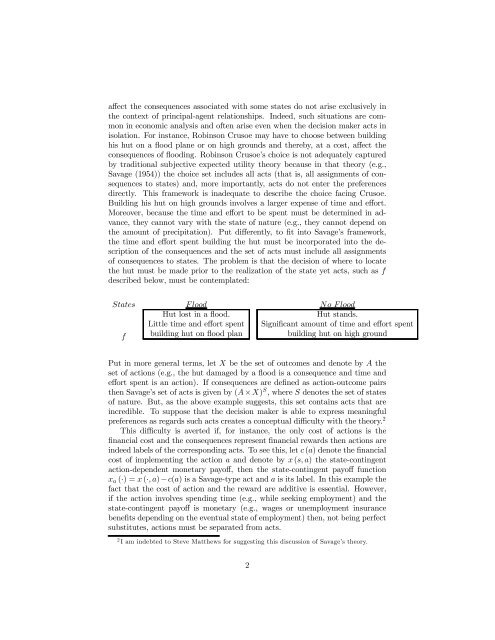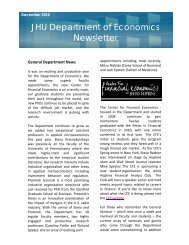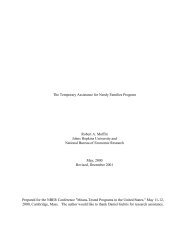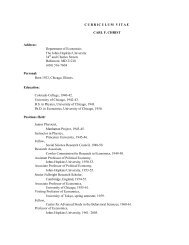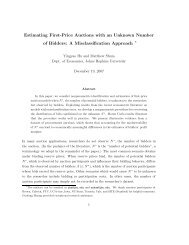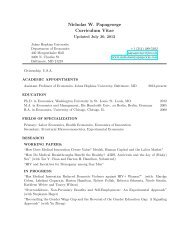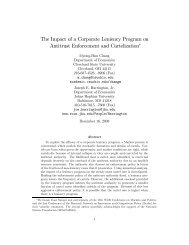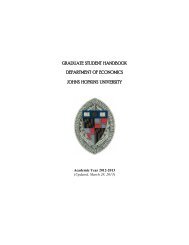Subjective Expected Utility Theory with Costly Actions - Economics ...
Subjective Expected Utility Theory with Costly Actions - Economics ...
Subjective Expected Utility Theory with Costly Actions - Economics ...
Create successful ePaper yourself
Turn your PDF publications into a flip-book with our unique Google optimized e-Paper software.
a¤ect the consequences associated <strong>with</strong> some states do not arise exclusively in<br />
the context of principal-agent relationships. Indeed, such situations are common<br />
in economic analysis and often arise even when the decision maker acts in<br />
isolation. For instance, Robinson Crusoe may have to choose between building<br />
his hut on a ‡ood plane or on high grounds and thereby, at a cost, a¤ect the<br />
consequences of ‡ooding. Robinson Crusoe’s choice is not adequately captured<br />
by traditional subjective expected utility theory because in that theory (e.g.,<br />
Savage (1954)) the choice set includes all acts (that is, all assignments of consequences<br />
to states) and, more importantly, acts do not enter the preferences<br />
directly. This framework is inadequate to describe the choice facing Crusoe.<br />
Building his hut on high grounds involves a larger expense of time and e¤ort.<br />
Moreover, because the time and e¤ort to be spent must be determined in advance,<br />
they cannot vary <strong>with</strong> the state of nature (e.g., they cannot depend on<br />
the amount of precipitation). Put di¤erently, to …t into Savage’s framework,<br />
the time and e¤ort spent building the hut must be incorporated into the description<br />
of the consequences and the set of acts must include all assignments<br />
of consequences to states. The problem is that the decision of where to locate<br />
the hut must be made prior to the realization of the state yet acts, such as f<br />
described below, must be contemplated:<br />
States Flood No Flood<br />
f<br />
Hutlostina‡ood.<br />
Little time and e¤ort spent<br />
building hut on ‡ood plan<br />
Hut stands.<br />
Signi…cant amount of time and e¤ort spent<br />
building hut on high ground<br />
Put in more general terms, let X be the set of outcomes and denote by A the<br />
set of actions (e.g., the hut damaged by a ‡ood is a consequence and time and<br />
e¤ort spent is an action). If consequences are de…ned as action-outcome pairs<br />
then Savage’s set of acts is given by (A £ X) S ; where S denotes the set of states<br />
of nature. But, as the above example suggests, this set contains acts that are<br />
incredible. To suppose that the decision maker is able to express meaningful<br />
preferences as regards such acts creates a conceptual di¢culty <strong>with</strong> the theory. 2<br />
This di¢culty is averted if, for instance, the only cost of actions is the<br />
…nancial cost and the consequences represent …nancial rewards then actions are<br />
indeed labels of the corresponding acts. To see this, let c (a) denote the …nancial<br />
cost of implementing the action a and denote by x (s; a) the state-contingent<br />
action-dependent monetary payo¤, then the state-contingent payo¤ function<br />
xa (¢) =x (¢;a)¡c(a) is a Savage-type act and a is its label. In this example the<br />
fact that the cost of action and the reward are additive is essential. However,<br />
if the action involves spending time (e.g., while seeking employment) and the<br />
state-contingent payo¤ is monetary (e.g., wages or unemployment insurance<br />
bene…ts depending on the eventual state of employment) then, not being perfect<br />
substitutes, actions must be separated from acts.<br />
2 I am indebted to Steve Matthews for suggesting this discussion of Savage’s theory.<br />
2


